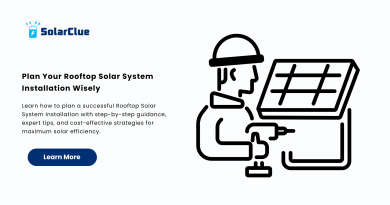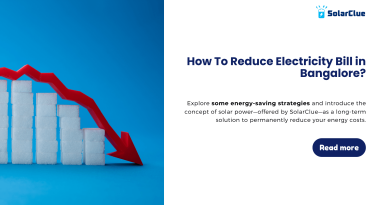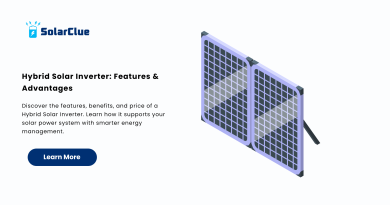Can Solar Panels Be Laid Flat?
Solar panel tilt is a critical factor that directly affects the efficiency and energy output of a solar power system. The angle at which solar panels are mounted can significantly influence how much sunlight they capture, thereby impacting overall energy production. This guide explores the importance of solar panel tilt, the factors influencing the ideal tilt angle, and the benefits of using adjustable mounts for optimal performance.
Table of Contents
- 1 The Importance of Solar Panel Tilt for Maximum Efficiency
- 2 The Impact of Latitude on Optimal Tilt Angle
- 3 Seasonal Variations and Their Influence on Tilt
- 4 The Role of Shading in Solar Panel Placement
- 5 Adjustable Solar Panel Mounts and Their Benefits
- 6 The Drawbacks of Flat Solar Panel Installations
- 7 Comparing the Performance of Tilted vs. Flat Solar Panels
- 8 Case Studies of Successful Solar Panel Installations with Different Tilts
- 9 The Future of Solar Panel Technology and Its Impact on Tilt Requirements
- 10 Table: Optimal Tilt Angles Based on Latitude
- 11 FAQ Section
- 12 Conclusion
The Importance of Solar Panel Tilt for Maximum Efficiency
1. Why Tilt Matters
- Sunlight Exposure: Solar panels are most efficient when they receive direct sunlight. The tilt angle determines how directly sunlight strikes the panel’s surface. Proper tilting maximizes sunlight absorption and enhances energy production.
- Energy Output: Without the correct tilt, solar panels may not receive optimal sunlight, leading to reduced energy output. Over time, this can significantly affect the overall efficiency of the solar power system.
2. Fixed vs. Adjustable Tilt
- Fixed Tilt: A fixed tilt angle is set during installation and does not change. It is typically calculated based on average conditions and is a simpler, more cost-effective solution.
- Adjustable Tilt: Adjustable mounts allow for the tilt angle to be changed seasonally or throughout the day, optimizing energy production under varying conditions.
The Impact of Latitude on Optimal Tilt Angle
1. Latitude as a Key Factor
- Definition: Latitude refers to the geographic coordinate that specifies the north-south position of a location on Earth. It plays a crucial role in determining the optimal tilt angle for solar panels.
- General Rule: A general rule of thumb is to set the tilt angle equal to the latitude of the installation site. For example, at a latitude of 30°, the solar panels should be tilted at 30° from horizontal.
2. Latitude Variations
- Equatorial Regions: Near the equator, the sun is almost directly overhead year-round, so a low tilt angle is sufficient to capture maximum sunlight.
- Higher Latitudes: In regions closer to the poles, a steeper tilt angle is required to capture sunlight effectively, especially during winter when the sun is lower in the sky.
Seasonal Variations and Their Influence on Tilt
1. Adjusting for Seasons
- Winter Tilt: During winter, the sun is lower in the sky, so a steeper tilt angle is necessary to capture more sunlight. The recommended tilt is typically latitude +15°.
- Summer Tilt: In summer, the sun is higher in the sky, and a shallower tilt angle (latitude -15°) can help maximize sunlight exposure.
2. Maximizing Year-Round Efficiency
- Fixed Angle: For those opting for a fixed tilt, setting the angle to the site’s latitude provides a balance that works reasonably well throughout the year.
- Seasonal Adjustment: For those using adjustable mounts, tilting the panels seasonally can significantly improve energy production, especially in regions with distinct seasonal variations.
The Role of Shading in Solar Panel Placement
1. Impact of Shading
- Reduced Efficiency: Shading from trees, buildings, or other obstacles can dramatically reduce the efficiency of solar panels, even if only part of the panel is shaded.
- Tilt Considerations: Proper tilting can sometimes help minimize the impact of shading by positioning the panels to avoid shadows during peak sunlight hours.
2. Optimizing Placement
- Site Analysis: Conducting a thorough site analysis before installation can help identify potential shading issues and determine the best tilt angle to minimize their impact.
- Use of Solar Pathfinders: Tools like solar pathfinders or software can help visualize shading throughout the year and assist in optimizing panel placement and tilt.
Adjustable Solar Panel Mounts and Their Benefits
1. Advantages of Adjustable Mounts
- Seasonal Optimization: Adjustable mounts allow you to change the tilt angle based on the season, ensuring that your solar panels are always positioned for maximum sunlight exposure.
- Increased Energy Production: By optimizing the tilt angle throughout the year, adjustable mounts can significantly increase the overall energy output of your solar power system.
- Flexibility: Adjustable mounts provide flexibility to adapt to changing conditions, such as new shading obstacles or changes in energy demand.
2. Types of Adjustable Mounts
- Manual Adjustments: These require manual adjustment a few times a year to match the optimal seasonal tilt angle. They are less expensive but require some maintenance.
- Automatic Trackers: These systems automatically adjust the tilt angle throughout the day or year, optimizing sunlight capture without the need for manual intervention. While more costly, they offer the highest efficiency.
The Drawbacks of Flat Solar Panel Installations
1. Lower Efficiency
- Minimal Sunlight Capture: Flat-mounted solar panels capture less sunlight compared to tilted panels, especially in non-equatorial regions, resulting in lower energy production.
- Suboptimal Year-Round Performance: Flat installations may perform adequately during summer when the sun is directly overhead but will underperform during winter and shoulder seasons.
2. Potential for Water and Debris Accumulation
- Water Pooling: Flat panels are more prone to water pooling, which can lead to dirt and debris accumulation, further reducing efficiency.
- Cleaning Challenges: Maintenance and cleaning may be more challenging with flat panels, as dirt and debris do not easily wash off with rain.
Comparing the Performance of Tilted vs. Flat Solar Panels
1. Energy Production
- Tilted Panels: Typically generate more energy due to better sunlight exposure, particularly in regions with varying seasons.
- Flat Panels: May be easier to install and are often used in urban environments, but they generally produce less energy.
2. Long-Term ROI
- Tilted Panels: The higher initial cost of installing tilted panels or adjustable mounts can be offset by the increased energy production and improved ROI over time.
- Flat Panels: While cheaper upfront, the lower efficiency may result in longer payback periods and less overall savings.
Case Studies of Successful Solar Panel Installations with Different Tilts
1. Residential Installation at High Latitude
- Location: A residential solar panel system in a high-latitude region (e.g., Norway) used a steep tilt angle to maximize winter sunlight capture.
- Outcome: The steep tilt increased winter energy production by 25%, significantly improving the system’s performance during the darkest months.
2. Commercial Installation with Adjustable Mounts
- Location: A commercial installation in a region with distinct seasons (e.g., New York) utilized adjustable mounts.
- Outcome: The system’s energy output increased by 15% annually due to seasonal adjustments, providing a quicker ROI for the business.
3. Urban Installation with Flat Panels
- Location: An urban building in a tropical region (e.g., Singapore) opted for flat-mounted panels due to space constraints and year-round sunlight.
- Outcome: While the system performed well during peak sunlight hours, it required frequent cleaning to maintain efficiency.
The Future of Solar Panel Technology and Its Impact on Tilt Requirements
1. Innovative Mounting Solutions
- Smart Trackers: Future developments in smart tracking systems could make adjustable mounts more affordable and accessible, leading to higher adoption rates.
- Self-Cleaning Panels: Technology advancements may lead to self-cleaning panels that mitigate some of the drawbacks of flat installations, such as debris accumulation.
2. Increased Efficiency Panels
- Bifacial Panels: Bifacial panels, which capture sunlight on both sides, may reduce the need for precise tilt adjustments, especially in environments with high albedo surfaces.
- High-Efficiency Materials: Advances in materials science could lead to panels that are less sensitive to suboptimal angles, further simplifying installation requirements.
Table: Optimal Tilt Angles Based on Latitude
| Latitude | Winter Tilt (°) | Summer Tilt (°) | Fixed Tilt (°) |
|---|---|---|---|
| 0° (Equator) | 15° | 0° | 5° |
| 15° | 30° | 0° | 15° |
| 30° | 45° | 15° | 30° |
| 45° | 60° | 30° | 45° |
| 60° | 75° | 45° | 60° |
FAQ Section
- Why is the tilt of solar panels important?
- The tilt angle of solar panels affects how much sunlight they receive, which directly impacts their efficiency and energy production. Proper tilting ensures maximum exposure to sunlight throughout the day and year.
- How do I determine the optimal tilt angle for my solar panels?
- The optimal tilt angle is generally equal to your latitude. For example, if you are at 30° latitude, tilting your panels at 30° will provide good year-round performance. Adjusting the tilt seasonally can further optimize energy production.
- What are the benefits of using adjustable solar panel mounts?
- Adjustable mounts allow you to change the tilt angle of your solar panels seasonally or even throughout the day, maximizing sunlight exposure and increasing overall energy production. They offer flexibility and can significantly improve efficiency.
- Can I install solar panels flat on my roof?
- While it is possible to install solar panels flat, this is generally not recommended unless you are in a tropical region with direct sunlight year-round. Flat installations can lead to lower efficiency, water pooling, and debris accumulation.
- How does shading affect solar panel tilt and placement?
- Shading can greatly reduce the efficiency of solar panels. Properly tilting the panels can help minimize the impact of shading, but it’s also important to conduct a site analysis to ensure that panels are placed in areas with minimal shading.
Conclusion
Solar panel tilt is a crucial factor in optimizing the performance and efficiency of your solar power system. By understanding the importance of tilt, considering factors such as latitude, seasonal variations, and shading, and utilizing adjustable mounts when possible, you can maximize your solar energy production. As technology continues to advance, the future of solar panel installations may bring even more flexibility and efficiency, ensuring that solar power remains a key component of sustainable energy solutions.



